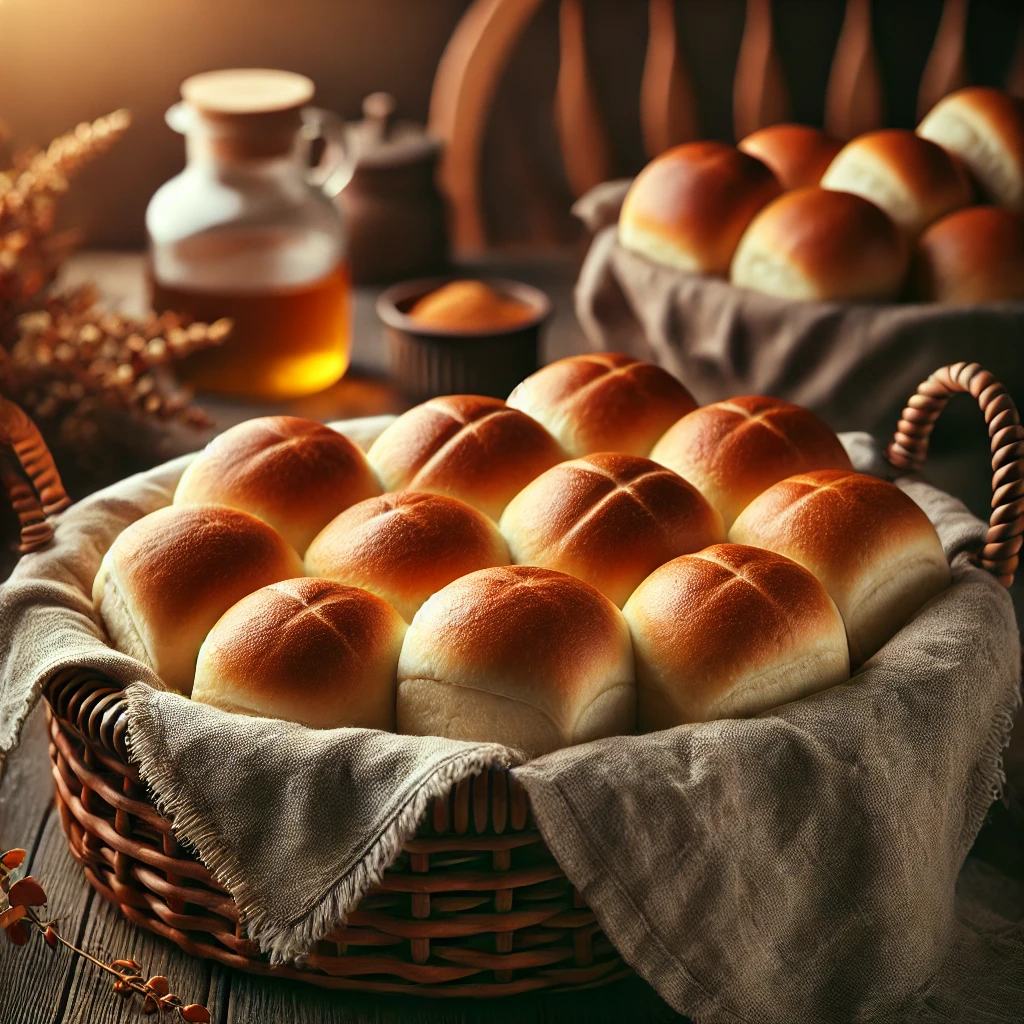Soft and Fluffy Dinner Rolls

Discover the secret to soft, fluffy dinner rolls that are perfect for any meal. These homemade dinner rolls are tender, buttery, and ideal for beginners and experienced bakers alike.
There’s nothing quite like the smell of freshly baked bread filling your kitchen, especially when it’s a batch of soft, fluffy dinner rolls. These rolls are a must-have for any dinner, from special holiday feasts to simple weeknight meals. Made with basic ingredients and simple techniques, this recipe yields incredibly soft and tender rolls with a beautiful golden crust that will make any meal feel extra special.
Dinner rolls are one of those classic recipes that can elevate any meal, making it feel a bit cozier and more satisfying. And while you might think making bread from scratch is complicated, these rolls are actually quite simple to prepare. With just a few steps and some patience for the rising time, you’ll have homemade rolls that are worlds apart from store-bought options.
Why These Rolls Are So Special
These dinner rolls are crafted to achieve a delicate balance of softness and fluffiness with just the right amount of sweetness. The ingredients work together to create rolls that are soft yet slightly chewy with a hint of buttery flavor. They’re perfect for spreading with a little butter, or for dipping into soups, gravies, and sauces.
What makes these rolls stand out is their versatility—they’re not only ideal for dinner but also make great mini sandwiches or snacks. You can even enjoy them the next day by toasting them lightly with some jam or honey.
Dairy-Free: To make this recipe dairy-free, you can replace butter with a dairy-free alternative.
Vegan: For a vegan version, substitute dairy butter with a vegan butter alternative.
Step-by-Step Instructions with Tips
To ensure you get the best possible results with your dinner rolls, let’s dive into the step-by-step process, with a few handy tips along the way.
- Activate the Yeast
Start by combining warm water, warm milk, and sugar in a large mixing bowl. Sprinkle the active dry yeast over the liquid and give it a gentle stir. Let the mixture sit for 5-10 minutes. You’ll know the yeast is active and ready to go when it begins to bubble and form a foamy layer on top. This step is crucial—if your yeast doesn’t foam, it may be old or the water might be too hot, which can kill the yeast. Aim for liquids that are warm but not hot (around 110°F is ideal). - Add Wet Ingredients
Once your yeast is active, add melted butter and a large egg. Stir these ingredients together until well combined. The butter and egg add richness and softness to the rolls, giving them that melt-in-your-mouth quality. - Incorporate the Dry Ingredients
Slowly mix in the flour and salt, starting with about 3 cups of flour and adding more as needed until a soft dough forms. You want a dough that’s soft and slightly sticky but not too wet. Be cautious not to add too much flour, as this can make the rolls dense and heavy. - Knead the Dough
Transfer the dough to a floured surface and knead for about 5-7 minutes until it becomes smooth and elastic. Kneading is essential as it helps develop gluten, giving structure to the rolls and making them soft and chewy. If you have a stand mixer, you can also knead the dough using the dough hook attachment. - First Rise
Place the kneaded dough in a greased bowl, cover it with a damp cloth or plastic wrap, and let it rise in a warm place for 1-2 hours, or until doubled in size. This rising time allows the dough to develop flavor and texture. Pro tip: If your kitchen is cool, you can create a warm environment by placing the bowl in the oven with the light on or near a warm stovetop. - Shape the Rolls
Once the dough has risen, punch it down to release the air and divide it into 12-15 equal pieces. Roll each piece into a smooth ball and place them in a greased baking dish or on a lined baking sheet. Properly shaped rolls will rise evenly and have a smooth, domed top. - Second Rise
Cover the rolls with a damp cloth and let them rise for another 30-45 minutes until they’re puffy. This second rise is what gives the rolls their light, airy texture, so don’t skip it! - Bake to Perfection
Preheat your oven to 375°F (190°C) and bake the rolls for 15-20 minutes or until the tops are golden brown. For an extra-soft finish, brush the rolls with melted butter immediately after they come out of the oven.
Pro Tips for Success
- Don’t Rush the Rising Process: Good rolls need time to rise, so be patient. Letting the dough rise slowly will give you a better texture and richer flavor.
- Use Fresh Yeast: Make sure your yeast is fresh and active. If it doesn’t foam up when you activate it, it’s likely expired or inactive.
- Check Dough Consistency: The dough should be slightly sticky but workable. Adding too much flour can make the rolls dense, so resist the urge to add more than needed.
Storing and Reheating
- Storing: Place any leftover rolls in an airtight container at room temperature for up to 3 days. For longer storage, you can freeze the rolls in a zip-top bag for up to 2 months.
- Reheating: To reheat, simply warm the rolls in the oven at 300°F (150°C) for about 5-7 minutes. Alternatively, microwave them for 10-15 seconds to make them soft and warm.
Serving Suggestions
These dinner rolls are versatile and can be paired with a wide range of meals. Here are a few ideas:
- With Soups and Stews: Perfect for dipping into a hearty bowl of soup or stew.
- As Mini Sandwiches: Slice the rolls in half and fill them with turkey, ham, or your favorite sandwich fillings for a delightful snack or light lunch.
- As Breakfast Rolls: Serve warm with butter, honey, or your favorite jam.
Frequently Asked Questions (FAQs)
- Can I use whole wheat flour instead of all-purpose flour?
Yes, but the rolls will be denser. You can try substituting half of the all-purpose flour with whole wheat flour for a healthier option that’s still relatively soft. - Can I make the dough ahead of time?
Absolutely! Prepare the dough, let it rise, shape the rolls, and then place them in the fridge overnight. The next day, allow them to come to room temperature and rise before baking. - What if I don’t have a warm place for the dough to rise?
You can use your oven as a proofing box by turning on the light (but not the heat) to create a warm, draft-free environment.

Soft and Fluffy Dinner Rolls
Ingredients
Method
- Start by combining warm water, warm milk, and sugar in a large mixing bowl. Sprinkle the active dry yeast over the liquid and give it a gentle stir. Let the mixture sit for 5-10 minutes. You’ll know the yeast is active and ready to go when it begins to bubble and form a foamy layer on top. This step is crucial—if your yeast doesn’t foam, it may be old or the water might be too hot, which can kill the yeast. Aim for liquids that are warm but not hot (around 110°F is ideal).
- Once your yeast is active, add melted butter and a large egg. Stir these ingredients together until well combined. The butter and egg add richness and softness to the rolls, giving them that melt-in-your-mouth quality.
- Slowly mix in the flour and salt, starting with about 3 cups of flour and adding more as needed until a soft dough forms. You want a dough that’s soft and slightly sticky but not too wet. Be cautious not to add too much flour, as this can make the rolls dense and heavy.
- Transfer the dough to a floured surface and knead for about 5-7 minutes until it becomes smooth and elastic. Kneading is essential as it helps develop gluten, giving structure to the rolls and making them soft and chewy. If you have a stand mixer, you can also knead the dough using the dough hook attachment.
- Place the kneaded dough in a greased bowl, cover it with a damp cloth or plastic wrap, and let it rise in a warm place for 1-2 hours, or until doubled in size. This rising time allows the dough to develop flavor and texture. Pro tip: If your kitchen is cool, you can create a warm environment by placing the bowl in the oven with the light on or near a warm stovetop.
- Once the dough has risen, punch it down to release the air and divide it into 12-15 equal pieces. Roll each piece into a smooth ball and place them in a greased baking dish or on a lined baking sheet. Properly shaped rolls will rise evenly and have a smooth, domed top.
- Cover the rolls with a damp cloth and let them rise for another 30-45 minutes until they’re puffy. This second rise is what gives the rolls their light, airy texture, so don’t skip it!
- Preheat your oven to 375°F (190°C) and bake the rolls for 15-20 minutes or until the tops are golden brown. For an extra-soft finish, brush the rolls with melted butter immediately after they come out of the oven.
Notes
Tips & Notes
-
Measure Flour Correctly
For best results, spoon flour into your measuring cup and level it with a knife. Avoid scooping directly from the bag, which can lead to packed flour and a denser roll. -
Check Yeast Freshness
Be sure your yeast is fresh and active. If using active dry yeast, it should bubble and foam when dissolved in warm water with a pinch of sugar, indicating it’s alive. If not, the yeast might be expired. -
Adjust Flour as Needed
Dough consistency can vary depending on humidity and flour brand. Add flour gradually and stop once the dough is smooth, soft, and slightly sticky. Too much flour will make the rolls dry. -
Use Warm Liquid for Yeast Activation
The milk or water used should be warm but not hot (around 110°F/43°C). Hot liquids can kill the yeast, preventing proper rise. -
Knead Well for Best Texture
Knead the dough until it’s smooth and elastic, about 5-7 minutes if kneading by hand. Proper kneading develops gluten, which gives the rolls their soft, airy texture. -
Room Temperature Butter
Make sure to use softened, room temperature butter, as it will incorporate into the dough more evenly and add a richer flavor. -
Brush with Butter After Baking
For extra flavor and softness, brush the tops of the rolls with melted butter as soon as they come out of the oven. This adds a lovely sheen and keeps the rolls soft. -
Storage Tips
Store any leftover rolls in an airtight container at room temperature for up to 2 days. You can also freeze baked rolls by wrapping them tightly in plastic wrap, then in foil, and storing in an airtight bag. Reheat frozen rolls in the oven for a few minutes before serving. -
Make-Ahead Option
Prepare the dough and allow it to rise. After shaping, place the rolls in the baking pan, cover tightly, and refrigerate overnight. Let them come to room temperature for about 30-45 minutes before baking. -
Add Toppings
For a twist, sprinkle sesame seeds, poppy seeds, or flaky sea salt on top of the rolls before baking for added flavor and texture.

